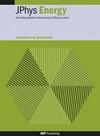用x射线吸收光谱和第一性原理计算阐明In2S3中V取代物的局域结构
IF 6.3
3区 材料科学
Q1 ENERGY & FUELS
引用次数: 0
摘要
研究了掺钒硫化铟In2S3:V作为中带(IB)太阳能电池的潜在吸收材料。基于电子方面的考虑,通常假设V占据八面体配位的In位,尽管几何方面的考虑有利于四面体In位。因此,在本研究中,我们将实验x射线衍射和x射线吸收光谱与α和β相的从头算理论计算相结合,以阐明在不同V含量和不同生长温度下生长的In2S3:V薄膜中V的掺入。比较测量和计算的V的x射线吸收边的形状和位置,比较实验确定和计算的V-S键长,以及评估计算的V在不同晶格位置上的溶解热,都表明V结合在In2S3基体中的八面体而不是四面体位置上。因此,对于这种材料系统,八面体配位的电子效益超过了相关晶格弛豫的机械应力。最后,我们使用混合密度泛函计算研究了V取代的α-In2S3的电子结构,发现当浓度为1.9at%时,V在八面体配位的In位点上形成了一个与价带和导带(CB)分离的空IB。然而,通过将V含量增加到3.8at%,IB和CB之间的间隙闭合,这导致带隙减小。这与β-In2S3:V计算的电子结构不同,并清楚地表明晶体结构和V掺入位点都会影响所产生的电子材料性质。本文章由计算机程序翻译,如有差异,请以英文原文为准。
Elucidating the local structure of V substitutes in In2S3 as potential intermediate band material by x-ray absorption spectroscopy and first principles calculations
Vanadium doped indium sulphide, In2S3:V, is studied as a potential absorber material for intermediate band (IB) solar cells. Based on electronic considerations, it is usually assumed that V occupies octahedrally coordinated In sites, although geometrical considerations would favour tetrahedral In sites. In this study, we therefore combined experimental x-ray diffraction and x-ray absorption spectroscopy with ab initio theoretical calculations of both α and β phase to elucidate the incorporation of V in In2S3:V thin films grown with different V content and different growth temperatures. Comparing shape and position of the measured and calculated x-ray absorption edge of V, comparing experimentally determined and calculated V–S bond lengths, and evaluating the calculated heat of solution of V on different lattice sites all indicate that V is incorporated on octahedral rather than tetrahedral sites in the In2S3 matrix. For this material system, the electronic benefit of octahedral coordination thus outweighs the mechanical stress of the associated lattice relaxation. Finally, we studied the electronic structure of V-substituted α - In2S3 using hybrid density functional calculations and find that for a concentration of 1.9 at %, V on octahedrally coordinated In sites forms an empty IB isolated from valence band and conduction band (CB). By increasing the V content to 3.8 at %, however, the gap between IB and CB closes, which results in a reduction of the band gap. This differs from the electronic structure calculated for β - In2S3 :V and clearly demonstrates that both crystal structure and V incorporation site affect the resulting electronic material properties.
求助全文
通过发布文献求助,成功后即可免费获取论文全文。
去求助
来源期刊

Journal of Physics-Energy
Multiple-
CiteScore
10.90
自引率
1.40%
发文量
58
期刊介绍:
The Journal of Physics-Energy is an interdisciplinary and fully open-access publication dedicated to setting the agenda for the identification and dissemination of the most exciting and significant advancements in all realms of energy-related research. Committed to the principles of open science, JPhys Energy is designed to maximize the exchange of knowledge between both established and emerging communities, thereby fostering a collaborative and inclusive environment for the advancement of energy research.
 求助内容:
求助内容: 应助结果提醒方式:
应助结果提醒方式:


